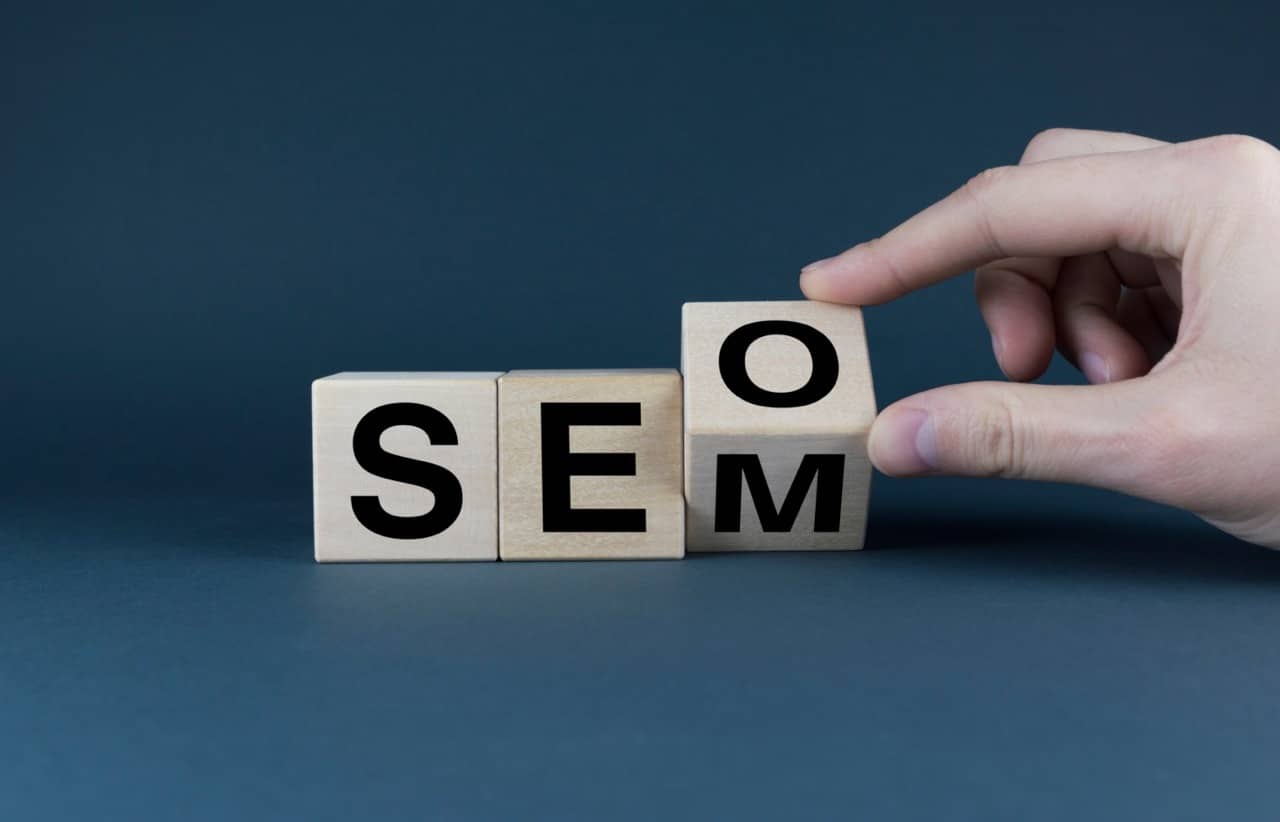

Ever wondered about the mysterious world of SEM and SEO? Figuring out the strange world of SEM and SEO can appear intimidating initially.
We’ve all been there. Trying to unravel the digital marketing lingo while juggling a thousand other tasks for your business. But, you’re not alone in this quest!
In this article, we’ll be decoding the jargon of SEM and SEO to help you make informed decisions for your business. You’ll discover their unique roles in digital marketing, understand their core components, learn when to use which one based on your goals or constraints, and more importantly, how they can work together like Vegemite and toast.
So sit tight! This might just be the guide you’ve been looking for…
In the realm of digital marketing, two heavyweights dominate – Search Engine Marketing (SEM) and Search Engine Optimization (SEO). While they may sound similar, these concepts are as different as chalk and cheese.
Picture this: SEM is like a paid expressway to your destination. It’s fast but costs you money every time you use it. On the other hand, SEO is akin to taking public transport – slower but much cheaper. This analogy gives us a starting point in understanding SEM and SEO.
SEM essentially involves leveraging search engines for visibility through both organic optimization (SEO) and paid advertising strategies (Paid-per-click or PPC campaigns). You pay to show up on SERPs (Search Engine Results Pages), aiming for immediate traffic boosts.
Moving onto our second hero – SEO. The key here lies not in paying but optimising content such that search engines find it relevant enough to feature high on SERPs organically over time. So while with SEM you buy visits, with SEO you earn them.
A successful digital strategy often employs an optimal blend of both approaches because relying solely on either can be risky. Relying purely on organic results might leave room for competitors using aggressive paid tactics, while overspending without strategic keyword research could result in financial pitfalls.
No single approach is suitable for all businesses. Your business needs, budget constraints, and industry competition all play crucial roles in determining the right mix of SEM and SEO for your brand. It’s a bit like deciding between a full-blown feast or an intimate dinner – what suits one may not suit another.
SEM, or Search Engine Marketing, plays a pivotal role in digital marketing. But what exactly is it? It’s all about promoting your website by increasing its visibility on search engine results pages (SERPs). This is primarily achieved through paid advertising.
Paid ads might seem like an unnecessary expense at first glance. However, when you consider the benefits they bring to the table, such as immediate results and precise targeting capabilities, their value becomes apparent.
A key feature of SEM that sets it apart from other strategies is speed. Unlike SEO which requires time for organic growth, with SEM your ad can start appearing on SERPs almost instantly after setup and payment.
In addition to instant visibility, another benefit of using SEM includes having full control over your budget. You decide how much you want to spend daily or monthly – this helps prevent overspending while still allowing flexibility for adjustment based on performance metrics.
You also have complete control over keyword selection for targeted campaigns which means you’re more likely reach people who are genuinely interested in what you offer rather than casting a wide net without any specific focus – ultimately leading to better ROI.
No strategy comes without potential drawbacks though; let’s be real here. With great power comes… well… responsibility.
Before taking the plunge into a SEM campaign, it is imperative to have an in-depth knowledge of the concept.
Key Thought:
SEM, or Search Engine Marketing, gives your website a visibility boost on search engine results pages through paid ads. Its speed and precision targeting are standout benefits but remember – it’s not without potential drawbacks like high costs if mismanaged. So ensure you’ve got a good grasp of SEM before diving in.
SEO, or Search Engine Optimization, plays a pivotal role in digital marketing. It’s like the secret sauce that makes your website appetising to search engines. But why is it so important?
Firstly, let’s think about how we use the internet. When you need answers or want to find a business, what do you do? You probably ‘Google’ it. In fact, over 1.5 billion websites are vying for attention on Google alone.
In this vast online landscape, standing out can be tough as an Aussie footy match. This is where SEO comes into play.
You see, Google uses algorithms (think of them as little robot judges) that rank sites based on their relevance and quality – this process is known as indexing.
If your site meets these high standards (like passing the MasterChef taste test), it gets ranked higher in search results. Higher rankings mean more visibility and more potential customers visiting your site.
This is the magic of good SEO practice.
Beyond just helping your site become more visible though; SEO also helps connect you with users who are looking for exactly what you offer by using targeted keywords.
SEO in digital marketing is basically about getting your website to ‘talk the same lingo’ as Google and prospective customers, which is a must for achieving success on the web. And that’s fair dinkum important for online success.
Key Thought:
Think of SEO as the magic ingredient in digital marketing. It spices up your website, making it irresistible to search engines like Google. With a whopping 1.5 billion websites vying for attention, SEO gives you that edge to rise above and get noticed – kind of like winning a MasterChef taste test. But remember, it’s not just about getting seen; strategic keyword use (like “Buy Australian”) plays a huge role too.
It uses paid strategies to help your business get seen online.
The core components include Paid Search Ads and PPC (Pay-Per-Click).
One strategy businesses use for visibility on search engines is Paid Search Ads. Search results can be boosted with the placement of Paid Search Ads at their top when users look up keywords associated with your business, and you’ll only pay for clicks. But here’s the fun part – you only pay when someone clicks on it.
This model allows you to effectively reach potential customers who are already interested in what you offer because they’re actively searching for those keywords. So with some clever keyword planning, this can be quite cost-effective.
The other crucial component of SEM is Pay-per-click or PPC advertising. Like its name suggests, these are ads where you pay each time a user clicks them.
A popular platform for running PPC campaigns is Google AdWords. However, there’s more out there like Bing and Yahoo. The great thing about Google Adwords, though, is how easy it makes tracking campaign performance so that you can adjust as needed based on real-time data.
In summary then: A successful SEM strategy will likely incorporate both paid search ads and PPC tactics into its approach; optimizing budget spend while maximizing exposure and engagement.
SEO, or Search Engine Optimisation, is a practical and adaptable tool for digital marketing. It’s like your trusty Swiss Army knife; versatile and practical. Let’s unpack its core components.
Akin to hunting for buried treasure, keyword research involves finding words that potential customers use when searching online. But instead of using a map and compass, we make use of tools like Ahrefs Keyword Explorer.
This helps us identify popular keywords relevant to our business niche – these are the golden nuggets.
If you think about your website as a library book (stay with me here), on-page optimization is what gets it into the right section so people can find it easily.
This involves crafting engaging meta descriptions, optimizing page titles with targeted keywords, and structuring URLs effectively – all helping Google’s ‘librarians’ understand where to place your site in their index.
Last but not least, off-page optimization represents activities outside your own website that affect rankings within search engine results pages (SERPs).
are just some examples.
The digital marketing world often tosses around terms like SEM (Search Engine Marketing) and SEO (Search Engine Optimisation). But what’s the real difference? Let’s break it down.
Think of SEM as a quick flight to your holiday destination, while SEO is more of a road trip. With SEM, you’re paying for visibility in search results – it’s faster but costs money. On the other hand, SEO aims at gaining free traffic through optimised content that ranks high organically—it takes time but is cost-effective.
If you want immediate visibility and have some budget to spare, then SEM might be your cuppa tea. You bid on keywords relevant to your business, allowing your ads to show up when users type these phrases into search engines. However, once you stop funding these campaigns—the visibility fades away.
In contrast, if sustainable growth tickles your fancy—SEO could do wonders. It involves improving website elements like meta tags or creating quality content based around keywords that attract organic traffic over time. The best part? These efforts can provide long-lasting results even after the work has stopped.
In reality, a well-rounded digital marketing strategy would integrate both to maximise online visibility. Comprehending the dissimilarities can aid in devising more judicious choices that are customised to your company’s necessities and objectives.
Key Thought:
Imagine SEM as a paid express flight, getting you fast visibility in search results. On the other hand, SEO is like a budget-friendly road trip that gradually brings free traffic with optimized content. While SEM offers quick wins that disappear once funding halts, SEO delivers long-term organic growth and lasting benefits even when work pauses. The secret to success? Blend both.
Deciding between SEM and SEO requires an evaluation of your business objectives, budget restrictions, industry competition etc. It’s more about understanding your business needs, goals, budget constraints, industry competition, etc., to make an informed decision.
If you need immediate results or are launching a time-sensitive campaign where visibility is key from day one – then SEM might be the way to go. Bid on terms associated with your offering and watch your adverts appear in search engine results almost immediately. But remember that this method requires constant funding.
On the flip side, if you’re looking for a cost-effective long-term strategy with sustainable organic growth – SEO could be your answer. It involves optimising your website content for relevant keywords so it ranks higher in search engine result pages naturally over time. However, bear in mind that SEO efforts take longer to yield noticeable results compared to SEM.
You could think of SEM like racing cars while SEO is akin to marathon running. In car racing (a.k.a SEM), speed matters most but comes at a high price tag whereas marathon runners (i.e., those who employ SEO strategies) pace themselves carefully aiming for endurance and consistency rather than instant victory.
In reality though, many businesses find success by combining both approaches into their digital marketing strategy. By using both tactics strategically, you can get the best of both worlds – instant visibility from SEM and sustainable growth from SEO. But as always, your decision should align with your business goals and resources.
Both SEM and SEO are powerful tools in the digital marketing toolbox. To achieve the best results, it’s important to employ SEM and SEO together. Let’s look at how we can leverage the advantages of both SEM and SEO to optimise your brand visibility.
A successful digital strategy isn’t about choosing between SEM or SEO; it’s about finding a balance that works best for your specific goals. Like a well-oiled machine, each part plays its role but when combined they make the whole operation run smoother.
An article by Search Engine Journal, likens this relationship to siblings – while they might have their differences, together they’re unstoppable.
To effectively integrate these two strategies you’ll first need an understanding of where your website currently stands within search engine rankings. This will help identify what needs more focus: paid advertisements (SEM) or organic traffic generation (SEO).
You also must understand which keywords drive most traffic towards your site so you can optimise both SEM campaigns and SEO efforts around them.
Remember, a combined SEM and SEO strategy is like a good cup of coffee – the right blend can make all the difference.
The digital marketing realm is vast, but two key players dominate it: Search Engine Marketing (SEM) and Search Engine Optimization (SEO). Though they may sound similar, these are distinct strategies with unique roles in driving online visibility.
Search Engine Marketing (SEM), at its core, involves using paid strategies to increase a website’s visibility on search engine results pages. This includes tactics like Pay-Per-Click advertising (PPC) where businesses pay each time their ad gets clicked.
Moving onto Search Engine Optimisation (SEO). It’s an organic approach that focuses on improving your site’s ranking in search results by optimizing elements such as keywords, content quality, and link building. A top-notch SEO strategy ensures your website appeals not only to users but also to search engine algorithms.
Sometimes people confuse SEM with being just PPC. But it’s more than that; while PPC is part of SEM, the latter also encompasses other paid search platforms beyond Google Ads. Think about Bing or Yahoo ads too.
In contrast, SEO doesn’t involve any direct payment to search engines. Its focus lies more towards crafting valuable content combined with strong keyword usage – all aimed at earning a high spot in organic listings over time rather than buying one upfront.
If you think of digital marketing as a game field – SEM represents quick sprints for immediate gains whereas SEO stands for long-distance marathons banking on steady progress over extended periods. HubSpot provides an excellent explanation.
Understanding the basics of SEM and SEO gives you a solid foundation to navigate the digital marketing landscape. It’s like getting your hands on a roadmap before setting off on an epic road trip.
Keywords are the beating heart of both SEM and SEO, acting as a bridge between your business’s online content and the users searching for it. They’re like breadcrumbs that lead customers to your digital doorstep.
Picking up on these keywords is not about stuffing them into every sentence but weaving them naturally into your content. Google’s algorithm has evolved past basic keyword matching, so relevancy matters more than repetition.
To pick winning keywords, you need to think like your customer – what would they type if they were looking for my product or service? Tools such as Google Keyword Planner can help with this process by suggesting related terms that might have slipped under your radar.
In an ideal world, we’d all rank organically for our chosen keywords without having to pay a cent; however, competition can make this difficult. This is where SEM comes into play: bidding on specific search terms via platforms like Google Ads lets you leapfrog organic rankings (for a price).
In contrast, SEO relies entirely on earning those top spots through high-quality content that answers user questions effectively while incorporating targeted keywords naturally.
Beyond just including relevant words or phrases within text bodies though, there are several other ways you can optimise for keywords:
Remember: search engines are looking for relevancy and quality – not keyword-stuffed nonsense. Keep this in mind when optimising content.
Key Thought:
Keywords are the lifeblood of SEM and SEO, tying your digital content to users. It’s not just about cramming in keywords but incorporating them naturally into meaningful content. To pick winning keywords, put yourself in your customer’s shoes and use resources like Google Keyword Planner for guidance. In a dog-eat-dog online world, SEM lets you outshine organic rankings by bidding on search terms while SEO zeroes in on earning top spots.
An SEO specialist focuses on organic traffic by optimising website content, while an SEM expert handles paid search strategies to drive immediate visibility.
SEM delivers quick results and specific audience targeting. It’s a powerful tool when you need instant visibility or for competitive keyword spaces.
The ‘best’ choice depends on your business goals. For long-term sustainable growth, opt for SEO; if speed and target precision are key, choose SEM.
SEO provides sustained traffic but takes time to work. Conversely, while SEM brings rapid results it can be costly in competitive markets.
Digital marketing, it’s a jungle out there! But now you’ve got the lowdown on SEM vs SEO – what is the difference?
SEM is your paid traffic. It’s all about immediate results but remember, once you stop paying those clicks vanish faster than beer at a barbie.
SEO? That’s your organic growth pal. Sure it takes time and patience like waiting for a summer rain, but when it hits, beautiful!
You’ve also learned that both have their place in digital strategy. Like snags and sauce at a Bunnings sizzle – they’re better together.
Moving forward use this knowledge to give your business an online boost or even build strategies with more confidence. Because knowing the game changes everything.






Copyright 2023 BSharp Technology Pty Ltd | ABN: 94 627 016 317 | ACN: 627 016 317 | Terms & Conditions | Privacy Policy
Please fill in this form and one of our customer service representatives will be in contact to discuss your website and complete the signup process.